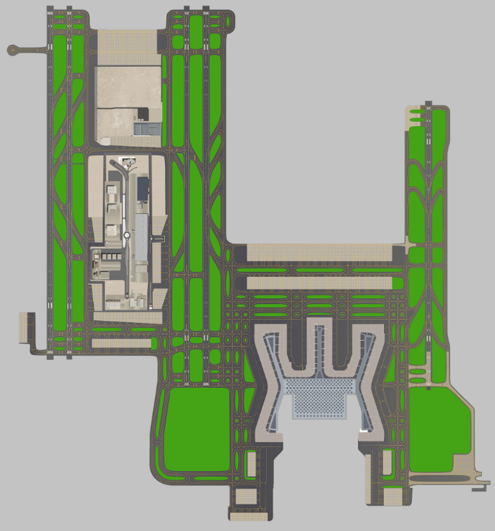Performance Evaluation of Machine Learning Algorithms in Estimating Taxi Times at Istanbul Airport
DOI:
https://doi.org/10.58190/imiens.2024.102Keywords:
Machine learning, Regression Algorithms, Taxi Time Prediction, Istanbul AirportAbstract
This article evaluates the performance of regression algorithms used to estimate taxi-out times at Istanbul Airport. Artificial neural networks, random forest, gradient boosting, and decision trees algorithms were studied to determine the algorithms with the highest accuracy. Principal Component Analysis (PCA) was used to reduce the data's dimensionality and improve model performance. The findings of the study provide valuable insights for more effective management of airport operations and reduction of flight delays. PCA-applied Artificial Neural Networks (ANN) emerged as the most successful algorithm, demonstrating the highest accuracy (R²: 95.89%) and lowest error margins (MAE: 0.016, MSE: 0.001) in predicting taxi-out times. This superior performance indicates that ANN can effectively capture the complex relationships and variability inherent in airport operational data. Following ANN, the PCA-applied Random Forest algorithm also showed commendable accuracy (R²: 94.89%), providing robust predictions with slightly higher error margins (MAE: 0.157, MSE: 0.044) compared to ANN. These results underline the potential of using advanced machine learning techniques to enhance the efficiency of airport operations, thereby minimizing delays and optimizing resource allocation. Overall, the application of these machine learning models, particularly ANN and Random Forest, offers a significant improvement over traditional methods. The study's outcomes suggest that incorporating these advanced algorithms can lead to more accurate predictions of taxi-out times, supporting better decision-making processes and operational strategies at airports.
Downloads
References
[1] J. a D. Atkin, E.K. Burke, S. Ravizza, The airport ground movement problem: Past and current research and future directions, Research in Air Transportation. (2010) 131–138. http://www.cs.nott.ac.uk/~smr/share/10_ICRAT_Ravizza.pdf.
[2] R.A. Shumsky, Dynamic Statistical Models for the prediction of aircraft take-off times, PhD Thesis. (1995) 1–214. papers2://publication/uuid/95251702-60DD-48BC-AE91-042F332CC19B (erişim 27 Nisan 2024).
[3] P. Balakrishna, R. Ganesan, L. Sherry, B.S. Levy, Estimating Taxi-out times with a Reinforcement Learning algorithm, AIAA/IEEE Digital Avionics Systems Conference - Proceedings. (2008). doi:10.1109/DASC.2008.4702812.
[4] A. Srivastava, Improving departure taxi time predictions using ASDE-X surveillance data, AIAA/IEEE Digital Avionics Systems Conference - Proceedings. (2011) 2B5-1-2B5-14. doi:10.1109/DASC.2011.6095989.
[5] R. Jordan, M.A. Ishutkina, T.G. Reynolds, A statistical learning approach to the modeling of aircraft taxi time, AIAA/IEEE Digital Avionics Systems Conference - Proceedings. (2010). doi:10.1109/DASC.2010.5655532.
[6] S. Ravizza, J.A.D. Atkin, M.H. Maathuis, E.K. Burke, A combined statistical approach and ground movement model for improving taxi time estimations at airports, Journal of the Operational Research Society. 64 (2013) 1347–1360. doi:10.1057/jors.2012.123.
[7] H. Lee, W. Malik, Taxi Time Prediction at Charlotte Airport Using Fast - Time Simulation and Machine Learning Techniques, (2015) 1–11.
[8] H.R. Idris, I. Anagnostakis, B. Delcaire, R.J. Hansman, J.-P. Clarke, E. Feron, A.R. Odoni, Observations of Departure Processes at Logan Airport to Support the Development of Departure Planning Tools, https://doi.org/10.2514/atcq.7.4.229. 7 (2016) 229–257. doi:10.2514/ATCQ.7.4.229.
[9] H. Idris, Observation and analysis of departure operations at Boston Logan International Airport [Ph.D. thesis], MIT, 2001.
[10] H. Idris, J.-P. Clarke, R. Bhuva, L. Kang, Queuing Model for Taxi-Out Time Estimation, https://doi.org/10.2514/atcq.10.1.1. 10 (2016) 1–22. doi:10.2514/ATCQ.10.1.1.
[11] F. Carr, A. Evans, J.P. Clarke, E. Feron, Modeling and control of airport queueing dynamics under severe flow restrictions, Proceedings of the American Control Conference. 2 (2002) 1314–1317. doi:10.1109/ACC.2002.1023202.
[12] I. Simaiakis, H. Balakrishnan, Queuing models of airport departure processes for emissions reduction, AIAA Guidance, Navigation, and Control Conference and Exhibit. (2009). doi:10.2514/6.2009-5650.
[13] J.E. Hebert, D.C. Dietz, Modeling and Analysis of an Airport Departure Process, https://doi.org/10.2514/2.2133. 34 (2012) 43–47. doi:10.2514/2.2133.
[14] O. Lordan, J.M. Sallan, M. Valenzuela-Arroyo, Forecasting of taxi times: The case of Barcelona-El Prat airport, Journal of Air Transport Management. 56 (2016) 118–122. doi:10.1016/J.JAIRTRAMAN.2016.04.015.
[15] J. Chen, M. Weiszer, E. Zareian, M. Mahfouf, O. Obajemu, Multi-objective fuzzy rule-based prediction and uncertainty quantification of aircraft taxi time, IEEE Conference on Intelligent Transportation Systems, Proceedings, ITSC. 2018-March (2017) 1–5. doi:10.1109/ITSC.2017.8317826.
[16] T. Diana, Can machines learn how to forecast taxi-out time? A comparison of predictive models applied to the case of Seattle/Tacoma International Airport, Transportation Research Part E: Logistics and Transportation Review. 119 (2018) 149–164. doi:10.1016/J.TRE.2018.10.003.
[17] J. Yin, Y. Hu, Y. Ma, Y. Xu, K. Han, D. Chen, Machine learning techniques for taxi-out time prediction with a macroscopic network topology, AIAA/IEEE Digital Avionics Systems Conference - Proceedings. 2018-September (2018). doi:10.1109/DASC.2018.8569664.
[18] LeCun, Y., Bengio, Y., Hinton, G., LeCun, Y., Bengio, Y., & Hinton, G. (2015-05-27). Deep learning. Nature 2015 521:7553, 521(7553). https://doi.org/10.1038/nature14539
[19] Sun, H., & Hu, X. (2017). Attribute selection for decision tree learning with class constraint. Chemometrics and Intelligent Laboratory Systems, 163, 16-23. https://doi.org/10.1016/j.chemolab.2017.02.004
[20] Breiman, L. (2001). Random Forests. Machine Learning, 45(1), 5-32. https://doi.org/10.1023/a:1010933404324
[21] Friedman, J. H. (2001). Greedy function approximation: a gradient boosting machine. Annals of statistics, 1189-1232.
[22] Inan, O., Uzer, M. S., & Yılmaz, N. (2013). A new hybrid feature selection method based on association rules and PCA for detection of breast cancer. International Journal of Innovative Computing, Information and Control, 9(2), 727-729.
[23] Karakoyun, M. (2024). Artificial neural network training using a multi selection artificial algae algorithm. Engineering Science and Technology, an International Journal, 53. https://doi.org/10.1016/j.jestch.2024.101684

Downloads
Published
Issue
Section
License
Copyright (c) 2024 Intelligent Methods In Engineering Sciences

This work is licensed under a Creative Commons Attribution-ShareAlike 4.0 International License.






